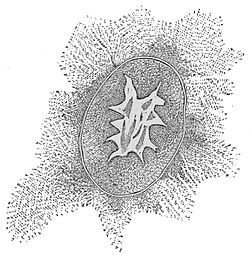and recent instance will suffice. After a remarkable series of experiments detailed before the Royal Society, Dr. W. Roberts says: "The issue of the foregoing inquiry has been to confirm in the fullest manner the main propositions of the panspermic theory, and to establish the conclusion that bacteria and torulœ, when they do not proceed from visible parents like themselves, originate from invisible germs floating in the surrounding aërial and aqueous media."[1]
But, farther, this has been remarkably sustained by analogical evidence. There are putrefactive organisms that closely approximate to the bacteria in form, structure, and size. These are the "monads" or, as Prof. Huxley doubtless more fitly names them, the heteromati.[2] They live side by side with the bacteria in the same putrescent mass, and certainly in the later stages of the disintegration of dead organic matter are the most active and powerful agents. From their greater size they present a more promising field for microscopical research than the bacteria themselves; and the life-history of some of there could be fully mastered. I long since felt that valuable aid might thus be rendered to the discovery of the nature of the bacteria. Armed with the best and most powerful appliances which the modern optician could supply, Dr. J. Drysdale and myself ventured on the work. The results are fully detailed elsewhere.[3] It need only be re-

Fig. 1.
marked here that the only hope of success was in continuous observation of the same form, in the same drop of fluid, under the highest powers. The secret, therefore, was to find a means of keeping the same drop under examination without evaporation. This we did.[4] The result was, that patient work enabled us to completely unravel
